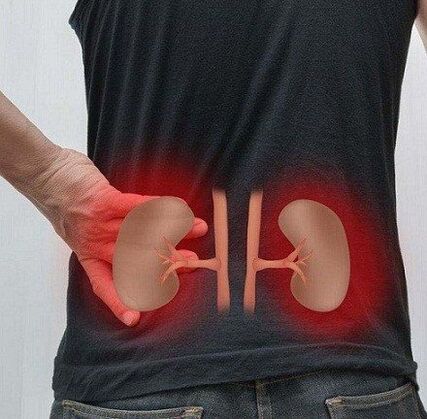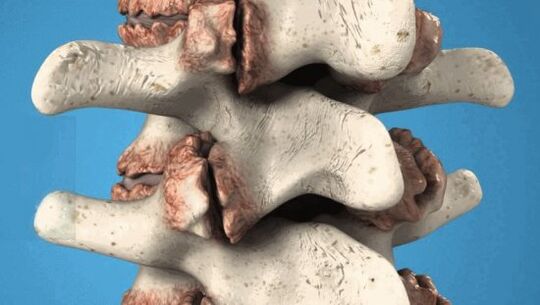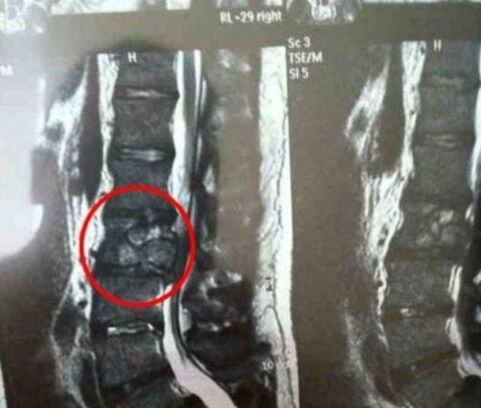
No one at least in his life will not experience pain in the lower back.With this, we pay for our uprising and household habits.
In addition to damage that can affect the spine, muscles, nerves and ligaments, keep in mind that sometimes the back in the lower support area is painful with internal diseases - kidney disease, gastrointestinal tract, and female genital organs.
Symptoms of pain in the lower back can vary from stupid to sharp.Pain can occur independently or go to chronic (symptoms present longer than three months).
Dangerous!
Take the doctor immediately if:
- Pain in the lumbar region arises significantly after a clear back injury;
- Temperatures rise significantly, there is autonomic disorders, loss of consciousness, sweating, difficulty breathing;
- Volunteering and bladder bladder;
- The taste is felt in the thigh;
- There are lower leg weakness, paresis or paralysis, impaired sensitivity;
- Pain is given to the stomach and increases with cough or sneezing;
- Symptoms appear to the background of sharp weight loss, long steroid use, immunodeficiency;
- In family history, there are cases of cancer, inflammation or degenerative bone-core tissue.
Why is the back pain in the bottom?
Miofascial pain
Muscle stretching or cramps can develop gradually or occur suddenly.With high load, damage is not only affected by muscle fibers, but also by ligaments and fascia.
Layer muscle pain appears after:
- raising overweight or overload during work or sports;
- Sports from time to time.The muscles are very exposed, if you are not active during the work week, and then spend the clock on the gym on the weekend;
- a sudden increase in their own weight, behind the muscles does not have time to develop;
- sitting old or standing in an uncomfortable position;
- daily wearing a bag on one hand or on the shoulder;
- Moster Disorders.The best spine performs its support and protective functions when you do not bend.The muscles in the lower back experience the smallest load when you sit with good support under the lower back, and in the evenly distributed weight to both feet.
If the back is painful after bruises, fractures, stretches, hypothermia, infectious diseases or helminthic invasion, then myositis (inflammation) of the back muscle may be suspected.Severe pain is always present due to inflammation of the muscle fibers, "nodules" are felt in the muscles.Inflammation can be acute or taking a chronic form.With long illnesses, unstable pain, increasing by lying down or sitting, closer to the evening or changing the weather.Touching the muscles causes pain and discomfort, the back muscles under constant tension, the form of inflammatory edema, the temperature rises locally and at the entire level of the organism.
In the case of muscle cramps, the root of the spinal cord is violated, so attacks often resemble images of ishias or radiculitis - burning severe pain behind the thighs and lower legs, the limbs are numb, and loss of sensitivity.The spoken muscle tone for myositis makes the patient take a forced position, he walks and lies around, moving on the leg half.
How to treat spinal muscles?To eliminate inflammation and pain, medications and anti -anti -ssteroidal analgesics are used.Medicines can be taken in the form of tablets, ointments, injections, transdermal plaster with gradual release of active ingredients.Angry ointment and heating are also used, which reflexive increases blood flow to the lower back muscles.Larger amounts of flowing blood helps to dispose of inflammation products and tissue damage.
Corticosteroid injections and vasodotonization drugs contribute to the decrease in inflammation.
If the cause of myosite is an infection or body poisoning with worm toxins, then therapy is initially performed with antibiotics or anthelmintic agents.In this case, it is impossible to use heating or compression ointment.
Ridge disease involving nerve endings
In the lumbar section, the vertebrae is separated by elastic cartilaginus discs that protect the ridge from injury, but they themselves are subject to wear and aging.
Usually, the disc is a pulp core like jelly surrounded by a compact layer of fibrous rings.The elasticity of the nucleus is due to its ability to bind and hold water: as the load increases, it accumulates water, and the elasticity increases, when the pressure is reduced, the core gives water and becomes evenly.
Osteochondrosis in the spinal department develops if it violates food discs (their "drying") or with excessive local loads.Often, lower back pain is due to the fact that the lower pole of the intervertebral disc carries the biggest load during the chair, when lifting the weight in front of them.At the same time, tears, displacements are formed on discs, damaged vertebral ligaments, persistent pain, and pulsations.
The pain in the spine has several developmental mechanisms:
- Violation of micro -circulation in the tissues surrounding the spine and, in particular, in the cerebrospinal canal, the formation of congestion and edema.Such conditions develop against the background of hypothermia, too hot, inflammation.
- Degenerative processes in spinal cord ligaments.Increased vertebral movement leads to simple and non -physiological displacement, which causes nerve, blood vessels, and hernia formation.
- Compression of the vertebral axis when lifting the weight or damage to them with excessive rotation (rotation).
- Aseptic inflammation.The destruction of the nucleus leads to the exit of the cerebrospinal tract factor -sensitivity factors.Nervous tip irritation occurs, which causes muscle cramps that violate neighboring vertebra - higher and under the hernia.Gradually, the reaction covers the entire lumbar and leads to the fact that any movement causes pain.
Weak discs can be torn by the formation of highlights, prominence or nucleus prolapse, and as a result - hernia.The appearance of hernia causes pressure on the spinal cord and the root of the spinal cord.In such cases, lower back pain appears significantly, which deviates along the violated nerves.The most famous sciatic nerve compression (Ishias) cases created by sharp pain in the posterior surface of the thighs and lower legs, numbness from the limbs from the hernia, muscle weakness, voluntary legs.
The pain in the lumbar spine is increasing in sitting and standing position, with turn, tendency.There are usually protective muscle reactions - painful muscle contraction (rollers) in both spine, which isolates the department from excessive movement.Osteochondrosis later leads to the appearance of lumbosacral radiculitis (inflammation of the spinal cord).
The spinal syndrome is dangerous with the lower back nerve violations responsible for the preservation of the internal organs (horse's root).At the same time, pain is given to the stomach, the function of the bladder and the intestine, the problem with potential in men and gynecological diseases in women.
Many patients, due to the fact that the lower back is very painful, take analgesic pose-push the body left if the right side is sick;Lie to the right if the hernia is on the left.The appearance of severe pain when pressed in the hernia in the intervertebral interval (call symptoms) is also a feature.
Instead of treating if the back hurts with osteochondrosis:
- During the pain attack, you can take an anesthetic pose - located behind you, and place a roller under your knees.It is also recommended to sleep on hard surfaces;
- From analgesic drugs, you can take NSAIDs into or in the form of injections in both sides of the spine in the lumbar hotel;
- Use local agents as a disruptive therapy - plaster mustard, mesh iodine, pepper and ointment;
- Eliminating mytical cramps by manual therapy, acupuncture, vacuum massage, reflexology, gymnastics;
- When fading acute period, you can use mud, ozokerite, heating.
Treatment of pain with radicular syndrome includes:
- Ensuring the bed regime, the lumbar region's attractiveness (dry or underwater);
- the use of analgesic blockade at the site of the violation, the acceptance of NSAIDs or poor opiates;
- Physiotherapy - micro stimulation, electrophoresis with analgesics.
Indications for surgery are persistent acute pain, as well as violation of internal organs, development of limb paralysis, hernia absorption in the spinal cord.
Degenerative-inflammatory lesions
Spondylarthrosis (vertebral curved joint inflammation) occurs during degeneration, decrease in height and the number of intervertebral discs.Lower back pain arises from the overstrain capsule and increases pressure on the surface of the intervertebral joints.Pain makes the patient bend more in the lower back, thus increasing the intervertebral joint load.Especially the discomfort in the lower back is enhanced by wearing shoes on the heel, walking, lowering the slope, positioning when the body returns, for example, when considering something on the head.
In patients with such a diagnosis in the morning, stiffness in the lower back is observed, pain increases during the day or after load.It has a spilled and difficult character to show boundaries: discomfort is determined in the gluteal muscle, the inguinal region, the lower stomach, in the scrotum in men.These spondylarthrosis is different from radicular syndrome, when you can show meaningful sources of pain.
What to do to relieve pain?Usually, the use of situations in the back helps, bending the legs in the hips and knee joints.
From medicines, priority is given to anti -medications -non -ssteroid and non -narcotic analgesics.With acute back pain, the introduction of NSAID intramuscularly has an intramuscular effect.

Musodi is also added, as they relieve muscle tension and increase spinal mobility.
Psychotherapy has a positive effect, as chronic pain introduces the patient into depression.
Spondylosis, unlike osteochondrosis, more affects the intervertebral disc and the front longitudinal ligaments.With this disease, the composite structure is used with formation along the edge of the vertebral growth - osteophytes.This formation causes a violation of micro -circulation near the nerve root and leads to the fact that the back in the lower pain, and the mobility of the department is limited.
Treatment is usually conservative, using anti -inflammatory drugs, analgesics, vitamins.Good effects provide electrophoresis, manual therapy, physiotherapy (amplipulse, laser installation, shock wave therapy to destroy compacted elements and increase spinal mobility).
Note!
In further stages, osteophytes are not absorbed.Although their dimensions are small, the treatment is intended to eliminate inflammation, pain, improves metabolism.If the back does not hurt, then nothing is done with growth.If osteophytes cause constant pain or large size, they can be removed during operation.
A disease of the nature of the tumor

Low pain can occur from the spinal cord compression with the exterior (extramedullary formation) and from the inside (intramedullar, which comes from the spinal material itself).
Cells from various tissues can grow pathologically:
- fat - lipoma formed;
- nerve root - neurioma;
- Spinal cord - hemangioma;
- Additional fabric - glioma;
- Bone tissue - osteosarcoma;
- Fabric cartilage - chondrosarcoma.
The tumor process, especially malignant, is characterized by pain, which resembles radiculitis (may have one and two -way), general deterioration in the patient's condition, fatigue.
If the pathology affects the lumbar vertebrae I IV, then the burning of the burn is felt ahead and on the upper thigh, the paralysis is incomplete in this area.
In the event of damage to the lumbar segment -sacral IV area, numbness from the paraghenic region, affected motor and sensitive preservation of gluteal muscle, back thighs, calves, and stool incontinence and urine are observed.
A clear violation of the work of the pelvic organs occurs during neoplasms in the sacred vertebral area v - iii.Patients have sexual impotence or menstrual impairment, constipation or impurities and urine incontinence.
Tumor treatment is specific, painkillers and antitumor drugs are prescription.
As you can see, lower back pain is usually caused by musculoskeletal pathology.They can be diagnosed by clinical signs and research data, which is the main task of determining the nature of the disease properly and not confusing with cancer, internal organ disease or injury.If back pain appears, we always recommend that you seek a neuropathologist or orthopedis for advice.

























